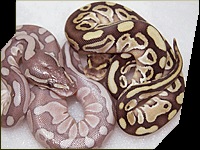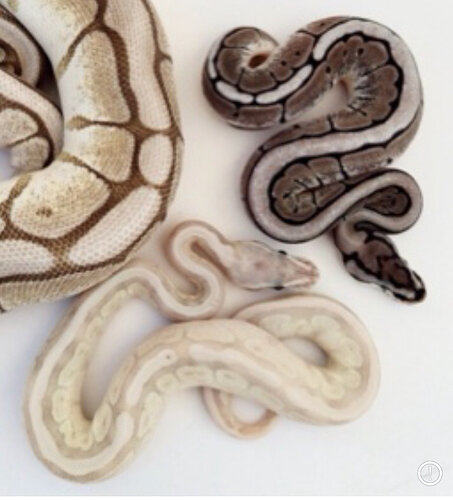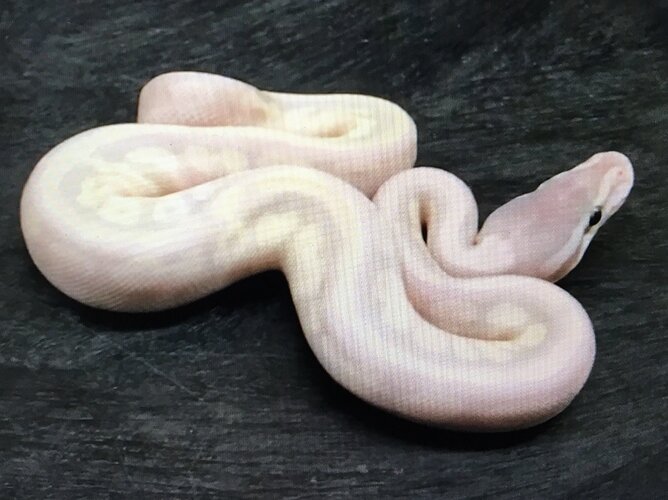Super lessers (a form of BEL) and super spiders are solid white snakes with no pattern (super spider is always lethal, and even seasoned breeders will tell you this). Adding axanthic to a BEL would not suddenly make it have pattern. Can we see pictures of the parents? As not even a BEL spider would look like that, since it still makes a solid white snake. The size of the patterning is making me think it doesn’t have spider though, as the areas that would normally be black would be thinner.
I do not believe you are looking at a parth event here. I think it is possible that you have the “Daddy” or similar allele floating around in that sire and your weirdo is the Axanthic heteroallelic superform BluEL Spider.
Can you provide a full clutch pic and pics of the parents?
I can probably post pics of both parents on Weds which is the next time I will at the breeders - I guess my confusion is how the baby can be a BEL if the male in the pairing has no lesser or other Leucistic genes…
I would definitely agree normally but I just found a bunch of information about how the spider gene looks when combined with leucistics and that threw me off! This pic is of a mystic potion spider and it looks the closest to the baby we have that I can find…
That is mystic potion (mystic Mojave) and not a super lesser. Mystic potions already have pattern/color to them and are not solid white. All the super lesser spiders I have seen are solid white. The only way people tell they have spider is from the presence of wobble/breeding them out.
Yes I realize this is a mystic potion and that they can have markings (although often they just have dorsal stripe and nothing else) I was just trying to illustrate the difference in the way the spider patterning shows up in a Leucistic combo.
Ok so to approach this another way… how can I have a BEL with these markings from the pairing of:
Lesser spider het axanthic
Axanthic genetic stripe
No lesser genes in the male or any other Leucistic genes and no retained sperm possibility for lesser or other Leucistic genes in the female - so how can there be a BEL baby?
Sorry Travis, I feel like I’m being a bit dim here but if the sire has no Leucistic genes and the Female is just a lesser NOT a super… then how can the baby be a BEL?
You are not dim, you are just not fully versed in all the alleles in the BluEL complex.
Twenty odd years ago, Ralph Davis imported an animal that he called the Platinum. When he bred the animal out, he got animals that looked normal and animals that looked sort of like Platinums but less extreme. He called these Lesser Platinum, and through the course of the last two decades the “Platinum” has been dropped and everyone just calls them Lesser now.
Now, here is the twist; those normal looking animals from the clutch, when bred to anything in the BluEL complex, resulted in animals that looked like more extreme versions of the single-gene form. Lessers became Platinums (or, as Ralph took to calling them, PlattyDaddys), Butters became ButterDaddys, Mojave became MojoDaddys, and Phantoms became Phantom44s (and if you want to know why that is then I guess you have a homework assignment LOL)
Early in the project, Ralph had let some of those normal looking animals into circulation because he just assumed they were normals. There have also been three (that I know of, but I quit tracking years ago so there could have been more) independent occurrences of the same type of “looks normal but makes Platty” animals being imported.
This gene has been dubbed the “Daddy” gene. It is the weakest allele of the BluEL complex. On its own, it is nearly indistinguishable from a typically normal animal. Even the “SuperDaddy” is a normal-looking animal.
Here is a great comparison of the Platty (Lesser/Daddy) compared to a single-gene Lesser

(Ralph’s photo)
Now, take the animal in that photo. Throw Spider on it, which gives you the pattern and adds another degree of wash down to the colour. Then make it Axanthic.
And the picture in your head now starts to look a lot like what you hatched out
Thank you that makes sense, I will
Investigate the other clutch mates and previous clutches from both parents and see whether there are any others that might have the daddy gene. I believe both parents in this instance are several generations in to being produced by this breeder so it would seem a little odd that no other similar anomalies have shown up… but perhaps if they were more subtle they might have passed unnoticed!
Thank you for your patience in explaining everything to me, just when I feel like I’m getting a vague handle on BP genetics something comes along and throws me for a loop.
Seriously fascinating stuff though!
You probably just need to track back along the sire’s line, that would be where the Daddy would be lurking.
So would the daddy be a sex related mutation?
Also I’m really struggling to find anything about phantom44s, there are a good few mentions of it on the internet but I can’t find anything around its naming. My only guess would be that someone was a halo fan ![]()
Since the female has lesser as a BEL gene, then the male would likely have the daddy gene somewhere in the lineage. It’s not a sex-linked trait as far as I’m aware.
^^^
This right here ![]()
.
.
.
Nope, that is not the correct answer LOL
Coming back to parthno, are they always produced with no pairing? Is it possible to have parthno offspring in a clutch where the male has donated genetic information? Does pairing help stimulte a female to go on to produce a parthenogenesis clutch?
If I’m not mistaken you can have a split partho clutch.
I’ve been thinking a little bit about partho clutches and are most partho laying females older? If so it would seem like they lay partho because if a female can live that long in the wild there should be more of them to strengthen the genetic population, kind of like another level of natural selection.
As Shawn noted below, it is not uncommon to see clutches that have both parthenogenetic and sexually produced offspring in them.
.
.
As far as snakes go, that has yet to be determined. There are some lizard species that require mating for clutch production though.
.
.
No, we just sort of have a false impression on that because the ones that make the news are solo animals from zoos and such that tend to have been alone in those collections for a long time. But when you look within the hobby itself it is not uncommon to see first time clutches being partho
Hi, does anyone know if it’s possible to get males in Partho clutches? Have a pastel Bourgogne female who was paired only to a firefly dg- 6 eggs only 3 made incubation. Pastel Bourgognes and a super pastel Bourgogne Male- no way the firefly is het for Bourgogne. So really confused- female was never bred beforehand. Thanks
It’s not possible. It might be possible to have a split partho clutch but I’m not positive. There’s a good discussion about males in partho clutches here:

